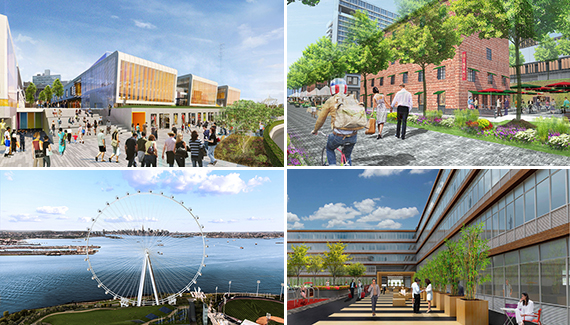Trending
Developers transforming Staten Island together, separately
Leaders behind Empire Outlets, Lighthouse Point and the NY Wheel discuss changes to come

Staten Island is enjoying a $1.3 billion injection of private capital. After decades of relative stagnation, forces have conspired to bring several massive projects to the waterfront of the “forgotten borough” at the same time — namely Empire Outlets, the New York Wheel, Lighthouse Point and URL Staten Island.
Thursday night, at the Urban Land Institute New York’s Borough Development Series, some of the biggest players at the helm of this transformation met to discuss the explosion of activity. Participants included Staten Island Borough President James Oddo, BFC Partners’ Joe Ferrara (Empire Outlets), New York Wheel president Richard Marin, Triangle Equities director of development Elysa Goldman (Lighthouse Point), and Snug Harbor Cultural Center and Botanical Garden CEO Lynn Kelly.
Here are some takeaways:
There is no master plan: Despite the seemingly cohesive push to develop the island’s waterfront over the next few years, all of these projects are privately funded and conceived, and there is no overarching strategy for receiving the millions of additional tourists per year that the developers hope to attract. This translates to an underlying anxiety about how the traffic will be handled. “Yeah, we’re going to have real infrastructure challenges,” Oddo said. “I would rather have the infrastructure challenges that are looming than have a waterfront that is totally underutilized.”
The goal is an “urban getaway”: In defining the brand of Staten Island, Marin, the New York Wheel developer, offered the vision of San Francisco’s serene counterpart, Sausalito. “Every major harbor has a big city and has something across the harbor that is an urban getaway,” he said. “I think New York needs that and New York is now going to get it.”
Bedroom community is here to stay: While Staten Island wants to see tourist dollars, it’s not ready to shed its reputation as a commuter hub and the quietest, safest, and most prosperous of all the boroughs. “There is lot of Staten Island that has been, and wants to continue to be, and should remain, a bedroom community,” Oddo said. Of Lighthouse Point, Goldman emphasized that she hopes to see local users. “We’re not only gearing ourselves to the tourists, but also certainly to the residents,” she said. And a certain amount of increased activity on other parts of the island wouldn’t be discouraged. “How are we going to get you to come back and go beyond the ferry terminal?” Kelly asked.
But it could use some younger folks: One topic of discussion was the borough’s lack of youth. But with the relatively low cost of living compared to other boroughs, young creatives are starting to migrate to Staten Island, and the panelists hoped that the new housing being built (900 units at Ironstate Development’s URL, 100 units at Lighthouse Point) would encourage the trend. “There’s a chance to have a critical mass of young people,” Oddo said, indicating that this could encourage office development as well. “They will come to where the talent pool is.”
New York Wheel has already broken ground: While the official ceremony may not happen until the fall, Marin said work has already been underway at the New York Wheel site for about a month. The 630-foot-tall structure will be five times the height of the highest point on the Staten Island Yankees Stadium next door, and will be able to take 2,200 people for a ride every hour — the number that the Empire State Building and One World Trade Center can take in an hour combined, according to Marin.
Beep James Oddo is a firecracker: For those unfamiliar with Oddo, his candor is quite something. Over the course of the hour-long panel he riffed freely on topics ranging from Staten Island stereotypes to the Public Design Commission.
“There is this perverse municipal self-flagellation that Staten Islanders do,” the Republican politician said of some of his constituents. “They love to wrap themselves around this forgotten borough, which obviously is grounded in fact and history. But it is not an excuse for apathy.”
Oddo also mentioned he once introduced a bill to dissolve the Public Design Commission, a board that is overseeing most of the current projects on Staten Island to some degree. The bill had the support of City Council members from both parties. “How could these ideologies meet up? … It was because the art commission, at the time, were a bunch of pompous asses. And they lived in the third floor at City Hall, and they delayed and delayed and said ‘no’ and ‘let them eat cake,’” he said.
The other panelists assured him that the commission has changed. Goldman said, “It’s mainly, overall, been positive.” Marin said he believes 70 percent of the commission’s ideas have added value to his project.
Of the impending traffic problems, Oddo’s outlook was somewhat bleak. “On this one I have no faith in the agencies,” he said. “I will not sit here and tell any of you that there is this wonderful plan that we’re going to put in place, because that plan doesn’t exist.”




